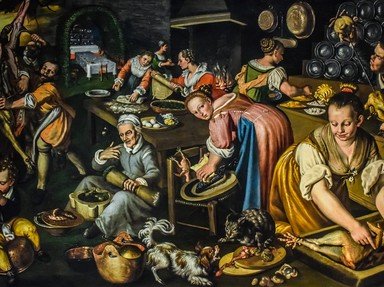Quiz Answer Key and Fun Facts
1. In the Treaty of Versailles it was specified that before peace with Germany could be concluded a particular masterpiece by the van Eyck brothers had to be returned to Belgium. What was its name?
2. As many other "Flemish" Primitives van Eyck was NOT born in what was then called Flanders, but at Maaseik, in the Bishopric of Liege, a dependency of the Holy German Empire. Who were his masters for the larger part of his life?
3. When van Eyck's Master, the Burgundian Duke Philip the Good, wanted to make up his mind whether to marry Isabella of Portugal or not, he sent his favourite painter to Lisbon on a reconnaissance mission, which included the making of her portrait.
4. Another Flemish Primitive who was not born in Flanders at all, but only worked for the Burgundian Court in Flanders, was Rogier de la Pasture aka Rogier van der Weyden. One of his best works is at the Hotel Dieu of a famous Burgundian wine-city of which the annual wine-auction is world famous. Where is that Hotel Dieu or Hospital?
5. After having been a disciple of Robert Campin from Tournai, Roger de la Pasture married Elizabeth Goffaert from Brussels, then a Flemish-speaking town. He changed his name into Rogier Van der Weyden. That was the name with which he signed most of his mature work. A typical aspect of it and difference with van Eyck is that:
6. How few "Flemish Primitives" were true natives of Flanders can be illustrated by the fact that van der Weyden was born at Tournai, then in France, Gerard David at Oudewater, in Holland, Dirc Bouts at Haarlem, Petrus Christus at Baarle in Brabant and the famous Hans Memlinc in ____________________.
7. Hugo van der Goes may have been born as an inhabitant of Ghent, and certainly started his career in that town. At the summit of his career, in 1475, he suddenly left Ghent for Brussels and became a lay-brother in the famous Red Cloister in the Sonien Forest. What had happened?
8. Apart from "the Big Names" there are some minor "Flemish Primitives" whose work is quite valuable too. One of them is Petrus Christus, who introduced geometric perspective into Flemish art. Another is Gerard David, who though born in Holland soon became the Dean of the Painters' Guild of Bruges. Which of these saints was traditionally the patron saint of medieval painters, and is still the patron saint many Flemish Painting Academies are named after?
9. Another "Dutch" member of the School of the "Flemish" Primitives is Dirc Bouts. Born in Haarlem, Holland, he studied in Brussels with Rogier van der Weyden. Soon he was to become the official painter of another Flemish town nl. the ancient University Town of ____________
10. Just as Hans Memlinc is famous for his "slender Madonnas", Hieronymus Bosch (1540-1516) is famous as a "painter of devils". Few people know that his name "Bosch" only refers to where he was born and died. Which of these was his real name?
Source: Author
flem-ish
This quiz was reviewed by FunTrivia editor
thejazzkickazz before going online.
Any errors found in FunTrivia content are routinely corrected through our feedback system.

